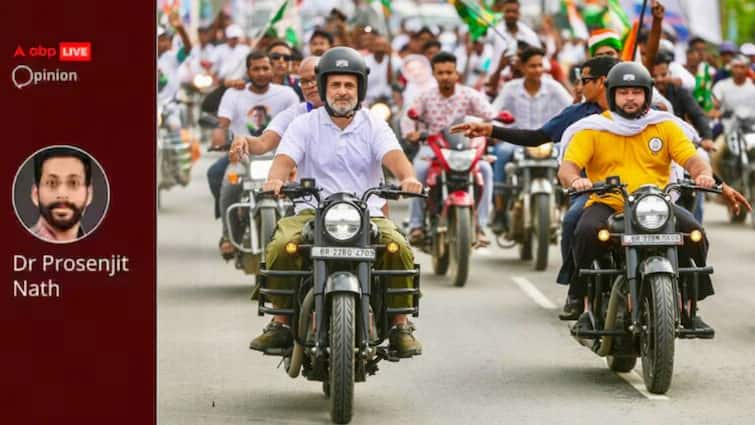The Congress Working Committee (CWC) meeting at Sadaqat Ashram in Patna this week is being projected as the grand old party’s big statement ahead of the Bihar assembly polls. By invoking the symbolism of history and parading Rahul Gandhi’s 1,300-km Voter Adhikar Yatra as a marker of revival, the party wants to signal that it is ready to lead the opposition INDIA bloc. But beneath the optics lies the familiar story of a party that has failed to outgrow its dependence on minority appeasement, hollow rhetoric, and fragile alliances.
Congress last ruled Bihar in 1990. Since then, it has steadily lost ground, reduced to a junior partner in the state’s political ecosystem. The vacuum was initially filled by Lalu Prasad Yadav’s Rashtriya Janata Dal (RJD), whose politics of Muslim-Yadav (M-Y) consolidation had dominated Bihar for decades. Congress chose the easier path, riding on RJD’s coattails instead of rebuilding its own organisation. Now, after three decades of decline, the party suddenly wants to reinvent itself as a serious player.
The timing is deliberate. The RJD under Tejashwi Yadav is a shadow of Lalu’s heydays. It has not managed a majority since 2005, and its attempts to go solo, as in the 2009 Lok Sabha polls, ended in disaster. Congress sees this weakness as an opening. More importantly, it senses that Muslim voters are no longer exclusively tied to the RJD. By parading itself as the “true national defender of minorities,” the Congress is desperately trying to win back Muslim loyalty, presenting itself as the safer bet within the INDIA bloc to stop the BJP.
This is the crux of Congress’s strategy: not governance, not economic ideas, not organisation, but the old trick of minority vote-bank politics. The Muslim vote, they argue, is “no longer an RJD monopoly.” The problem with this thinking is clear it reduces politics in Bihar to competitive appeasement, a race to prove who can promise more to the minority community, while ignoring the aspirations of the state’s majority population.
Rahul Gandhi’s Voter Adhikar Yatra is being marketed as a people’s movement. But what does it really stand for? Beyond the lofty slogans, it is yet another attempt to project himself as a “protector” of Muslim rights. If Congress truly wanted to revive in Bihar, it would focus on the issues of governance, corruption, jobs, and law and order issues, where both Congress and RJD have a dismal track record. Instead, the narrative is about consolidating a vote bank, not addressing Bihar’s real challenges.
Congress is also trying to expand beyond the M-Y base by eyeing the non-Yadav OBCs. It believes that with Nitish Kumar’s diminishing credibility, these groups might be up for grabs. But this is easier said than done. The BJP has already built a strong connection with Extremely Backward Classes (EBCs) and Dalits through welfare schemes, infrastructure development, and targeted outreach. In contrast, Congress has no credible grassroots organisation in Bihar. In 2020, it contested 70 seats but managed to win only 19, while the RJD secured 75 out of 144. This hard reality makes Congress’s tall claims look laughable.
Even within the INDIA bloc, friction is inevitable. Over-courting non-Yadav OBCs could easily create resentment among RJD’s traditional Yadav leadership. And if Congress pushes too aggressively for Muslim votes, it risks being seen as undercutting its own ally. The so-called “unity” of the INDIA bloc will be tested the moment seat-sharing talks intensify. History shows that Congress and its allies often collapse under the weight of contradictions and ego battles.
Meanwhile, the BJP stands as the most organised force in Bihar. It does not need symbolic yatras or heritage backdrops. Its strategy is grounded in booth-level management, micro-caste calculations, welfare delivery, and a clear nationalist narrative. Congress, on the other hand, is banking on optics, Rahul Gandhi’s yatra, Tejashwi’s roadshows, or grand declarations at CWC meetings. These may attract headlines but rarely translate into votes.
The Congress also claims that having a Dalit as its state unit chief will automatically draw Dalit votes. This is wishful thinking. Voters in Bihar are not swayed by tokenism anymore. They want performance, credibility, and a sense of belonging in the national mainstream. The BJP has successfully positioned itself as that mainstream force, while Congress and RJD remain trapped in old formulas.
At the end of the day, Congress’s Bihar gamble looks less like a revival plan and more like a recycled playbook. It is trying to repackage minority appeasement as “revival politics,” while ignoring its lack of cadre, weak leadership, and dependence on allies. The CWC meeting at Sadaqat Ashram may generate some nostalgia, but nostalgia does not win elections.
For voters in Bihar, the real question is whether they want to go back to the chaos of the Congress-RJD era or move forward with a party that talks about governance, infrastructure, and national pride. Congress’s strategy, steeped in appeasement and contradictions, may energise its ecosystem for now, but when the ballots are counted, Bihar is unlikely to provide Rahul Gandhi the “revival story” he so desperately seeks.
(The writer is a technocrat, political analyst, and author)
Disclaimer: The opinions, beliefs, and views expressed by the various authors and forum participants on this website are personal and do not reflect the opinions, beliefs, and views of ABP Network Pvt. Ltd.

